Wilderness and Culture Class
Week 9 – Week of Nov 8
Big History Unit 1
Earth History Timeline, Geology, Rocks, Clay
Monthly Unit: Big History Unit 1 (Natural History)
Weekly Topic: Earth History Timeline, Geology, Rocks, Clay
Homework Title:
Universe & Earth History Timeline & Geology
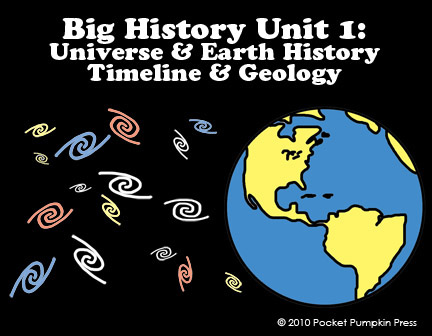
Earth History is Interdisciplinary: Astronomy, Physics, Chemistry, Earth Science, Geology, Meteorology, Oceanography, Paleontology, Biology, Botany, Zoology, Ecology, Evolution, etc.
Big History Unit 1: Natural History:
Segment of Interdisciplinary History Timeline, Big History
Selected Highlights
dates are very rough and approximate!
many natural history dates are rounded to closest 50 million
13.8 bya (billion years ago) – the universe formed
the Big Bang, the beginning of this physical universe
Physics: within the first second of the universe, there were the 4 forces of physics:
1. strong force, which holds an atom’s nucleus together
2. electromagnetic force, which holds atoms & molecules together
3. weak force, which changes protons into neutrons
4. gravity, which is masses attracting each other, and the curvature of space-time.
The universe starts as a tiny point and then expands quickly.
In only 1-minute, the universe grows to 34-lightyears in diameter – that’s 6 trillion miles in diameter.
For thousands of years, the universe is a dark, hot, expanding cloud of particles.
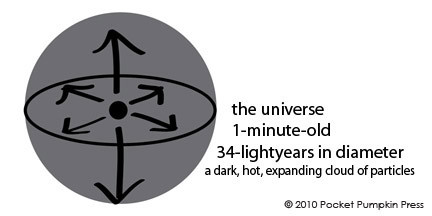
Chemistry: 380,000 years after big bang,
there’s chemistry:
hydrogen forms
hydrogen is the first atom
The instant that hydrogen first forms: the universe makes a first flash of light. The first flash of light can be seen by radio telescopes today as the cosmic microwave background thermal radiation. Optional: see image of cosmic microwave background thermal radiation at
http://www.astro.wisc.edu/~sparke/ast103/lecture26.html
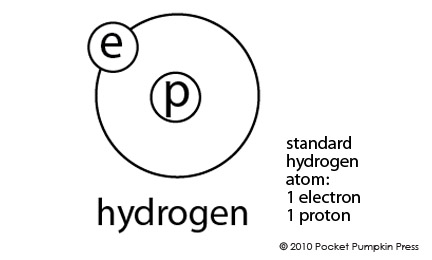
After that first flash of light of cosmic microwave thermal radiation, the universe continues to be a dark, hot, expanding gas cloud for millions of years.
400,000,000 (400 million) years after big bang, the first stars form.
1,000,000,000 (1 billion) years after the big bang, the first galaxies form.
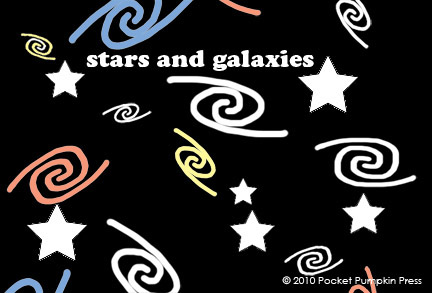
Stars are at least 27 million degrees F. While that hot, stars undergo nuclear fusion which turns hydrogen into helium. The nuclear fusion in stars plus the exploding death of large stars make 91 atomic elements. Optional: see a period table of atomic elements http://www.ptable.com/
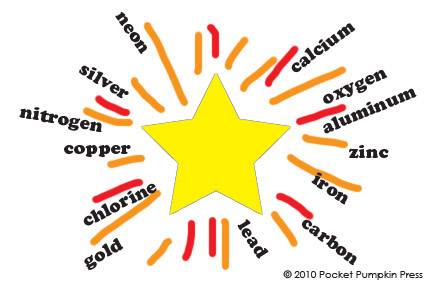
The most common elements in universe: 74% of atoms in the universe are hydrogen, 24% are helium, and less than 2% are oxygen, neon, nitrogen, carbon, silicon, magnesium, iron, sulfur, and others.
These elements form into planets and become the rocks, air, liquids, and creatures of those planets.
For example, Geology: Earth’s crust is mostly silica, which is silicon and oxygen (SiO2). Sand is mostly quartz, which is silica. Granite, Feldspar, sand, silt, and clay consist of silicon, oxygen, and aluminum. Silicates are minerals that consist of silica. Silicates are the most abundant minerals in the earth's crust.
Sand, quartz, silica (silicon and oxygen, SiO2)
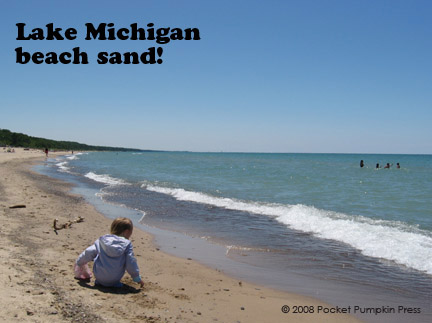
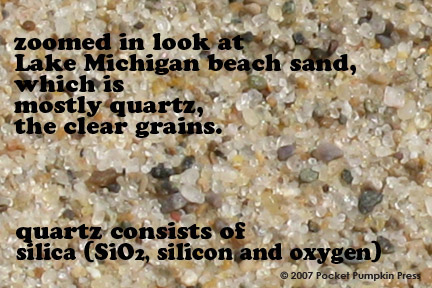
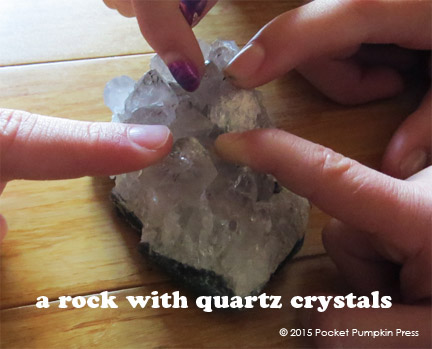
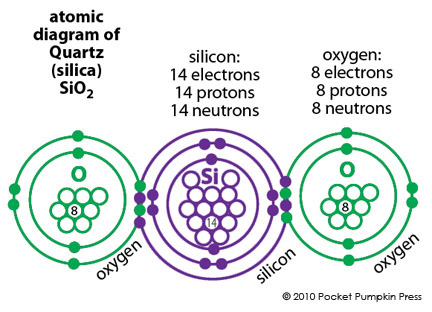
10 billion years after the Big Bang: Sun and Earth formed
5 billion years ago: Sun and Earth formed
4 bya - the first life: bacteria, a cell without a nucleus
3 bya - the first continent (Ur),
stromatolites (photosynthetic bacteria) put oxygen in atmosphere
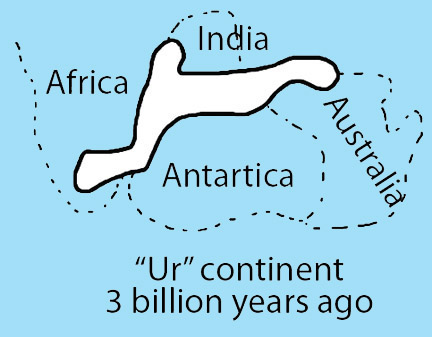
2 bya - the first eukaryote cell, a cell with a nucleus, some of these cells later evolved into plants and animals
1 bya - Rodinia Supercontinent
The earth has plate tectonics, which slowly and continually moves and changes the shape of continents. (Currently, the North American continent is moving 1-inch per year.) The position and shape of continents noticeably change every 50 million years. A few times during earth’s history, plate tectonics has pushed all the continents together into supercontinents. There was the supercontinent Rodinia, a billion years ago. (See below: today’s world map compared to the world map of a billion years ago.)
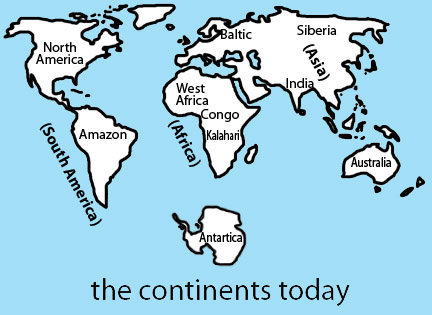
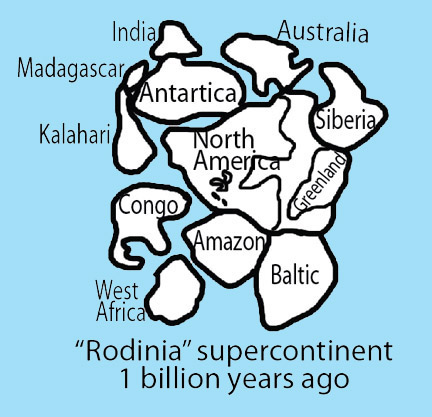
Optional: a 4-minute video of
earth’s continents drifting for 3 billion years
https://www.youtube.com/watch?v=UwWWuttntio
1 bya - first multi-celled animal
1 bya - first multi-celled animal: the sponge
700 mya (million years ago) Vendian Period,
animals: charnia, dicksonia, etc.
700 mya - Snowball Earth
earth is covered with ice for 100 million years
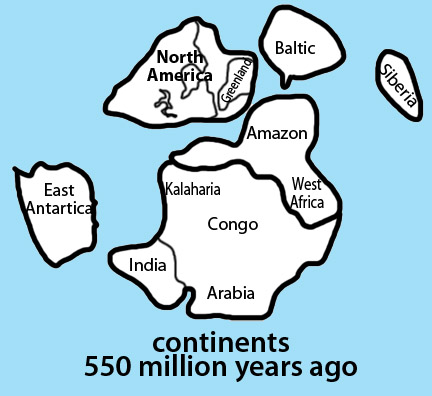
550 mya - Paleozoic Era
550 mya - Cambrian Period,
flat worms, trilobites, huge shrimp, etc.
500 mya - Ordovician Period,
first vertebrates, first jawless fish
450 mya - Silurian Period
first plants and animals to live on land
400 mya - Devonian Period,
first amphibians
350 mya - Carboniferous Period,
first reptiles, huge insects,
lycopod-club-moss & fern-like-tree swamps
300 mya - Permian Period,
first conifer plants with cones,
first proto-mammals
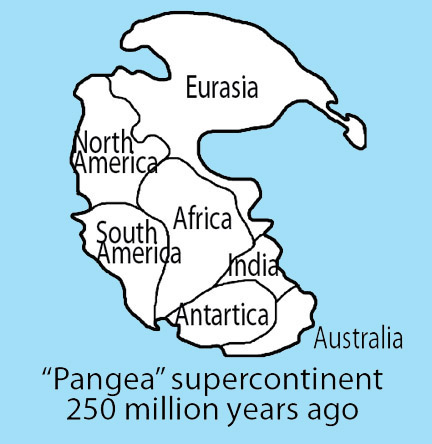
250 mya - Mesozoic Era
250 mya - Pangea Supercontinent
250 mya - Triassic Period,
first mammals, first dinosaurs
dinosaurs: fabrosaurus, scheromochlus, etc.
200 mya - Jurassic Period,
dinosaurs: diplodocus, stegosaurus, etc.
150 mya - Cretaceous Period,
first birds, first flowers,
dinosaurs: tyrannosaurus, triceratops, etc.
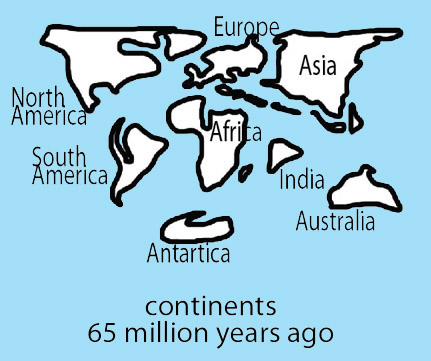
65 mya - Cenozoic Era
65 mya - Tertiary Period
dinosaurs go extinct
mammals start to grow bigger
25 mya - first grasses,
horses, cows, sheep, etc.
6 mya - ancestor of chimpanzees and humans
2.5 mya - Quaternary Period,
many human species existed at different times
2.5 mya - Homo habilis, Handy Man (stone tools)
1.5 mya - Homo erectus, Upright Man (makes fire)
200,000 ya - Homo sapiens, Modern Man

Quiz Nine
1. Since the universe began, the first atomic element to form was hydrogen. When did hydrogen first exist?
a.) during the first second of the Big Bang
b.) 380,000 years after Big Bang
c.) the earth’s sun made hydrogen 10 billion years after the Big Bang
d.) factories started making hydrogen 50 years ago
2. Along Lake Michigan, at the beach, there is lots of sand. Sand is mostly quartz, which consists of which two atomic elements?
a.) gold and silver
b.) hydrogen and helium
c.) oxygen and silicon
d.) hydrogen and oxygen
3. What is the name of the supercontinent that had formed by 250 million years ago, just before the first mammal and first dinosaurs existed?
a.) Ur
b.) Rodinia
c.) North America
d.) Pangea
4. Human species have existed for how many years?
a.) 2.5 million years
b.) 25 million years
c.) 250 million years
d.) 25 billion years
|















